Last Thursday evening the moon was due to rise in an interesting spot. I checked PhotoPills and The Photographer’s Ephemeris, and it looked like you’d see the nearly-full moon rise right over Half Dome if you were standing at Tunnel View. But I wasn’t sure the moon would be visible, as there were a lot of clouds.
On Tuesday and Wednesday most of California had received a good soaking – the biggest storm the state has seen in two years. Yosemite Valley got about 1.4 inches of rain, and a foot or two of snow above 8,000 feet; a decent amount, and enough to get the waterfalls flowing again, but some areas to the north and south got much more precipitation. The drought is far from over, as we need many more storms like this just to reach average rainfall levels for the winter. But it was a good start.
The storm started to clear early Thursday morning, so I drove up to Tunnel View for sunrise. It was too cloudy at first, but then the sun broke through and hit El Cap, and some beautiful sunbeams appeared to the right of Cathedral Rocks (see the image below).
Since I had some business in the valley that afternoon, I hung around, napping in my car and working on my laptop. During my meeting later I kept checking the satellite images and webcams on my iPhone, but it looked like there were a lot of clouds. We took a break at 3:45 p.m., so I stepped outside, and the weather actually looked more promising. The clouds were broken, with shafts of light reaching the cliffs. Even if the moon didn’t appear, it could be an interesting sunset. Gotta go!
There were, not surprisingly, quite a few photographers at Tunnel View. Everyone was anxiously awaiting the moon, but there were a lot of clouds around Half Dome. Gradually, however, the clouds started to dissipate. Then the edge of the moon appeared right above Half Dome. It was pretty quiet for the next ten minutes, except for the sound of shutters clicking. The moon was in a great position, and the clouds and misty valley floor added an extra dimension to the scene.
After sunset I returned to the meeting. But on my way home later I found some beautiful, moonlit, clearing-storm scenes at Gates of the Valley and Tunnel View (see below). The moon was high overhead, so these scenes didn’t have the color I found in El Cap Meadow the other night, but I liked the silvery light in these images.
This was another really beautiful day (and night) in Yosemite. I know there were a lot of other photographers in the valley on Thursday, and I always like to see what other people are up to, so if you photographed that moonrise, or would like to share other photos of Yosemite from last week, please post a link to your images in the comments!
— Michael Frye
P.S. For more information about photographing moonrises and moonsets, see this post.
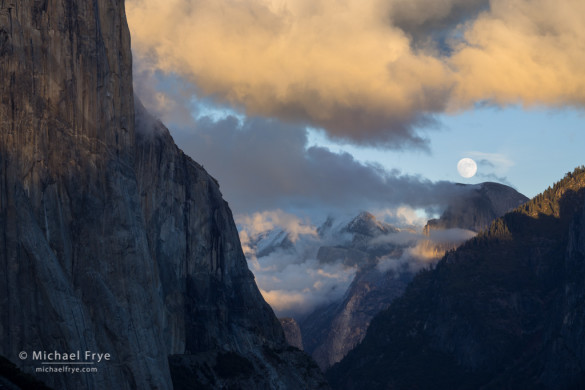
Moon rising above Half Dome, Thursday evening (this image was made a few minutes earlier than the one at the top of the post)
Related Posts: Moonstruck; Moonrise From Tunnel View; Moonbeams Over Yosemite Valley
Did you like this article? Click here to subscribe to this blog and get every new post delivered right to your inbox!
Michael Frye is a professional photographer specializing in landscapes and nature. He is the author or principal photographer of The Photographer’s Guide to Yosemite, Yosemite Meditations, Yosemite Meditations for Women, Yosemite Meditations for Adventurers, and Digital Landscape Photography: In the Footsteps of Ansel Adams and the Great Masters. He has also written three eBooks: Light & Land: Landscapes in the Digital Darkroom, Exposure for Outdoor Photography, and Landscapes in Lightroom 5: The Essential Step-by-Step Guide. Michael has written numerous magazine articles on the art and technique of photography, and his images have been published in over thirty countries around the world. Michael has lived either in or near Yosemite National Park since 1983, currently residing just outside the park in Mariposa, California.

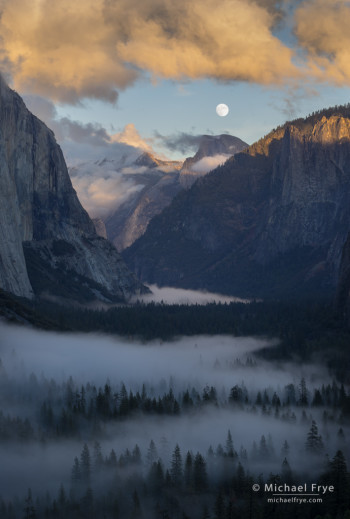
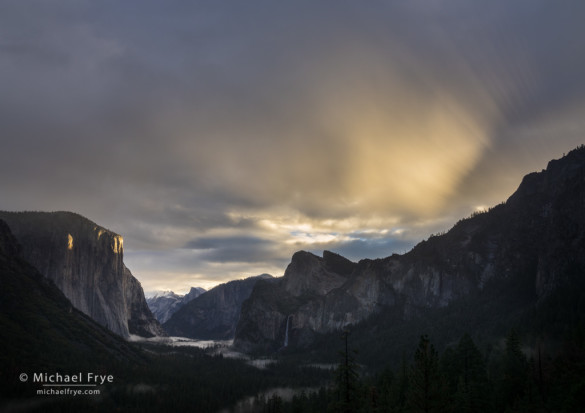
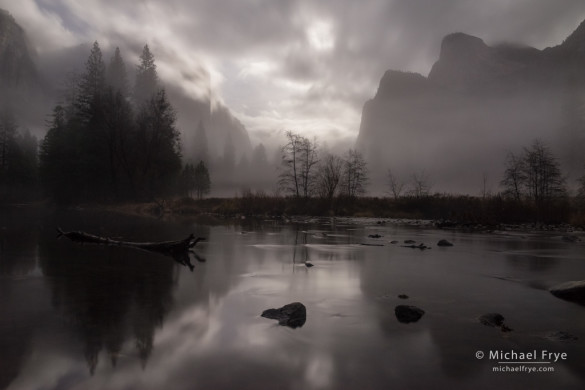
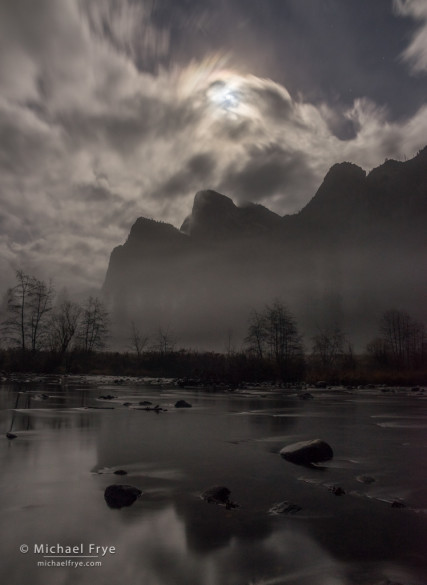
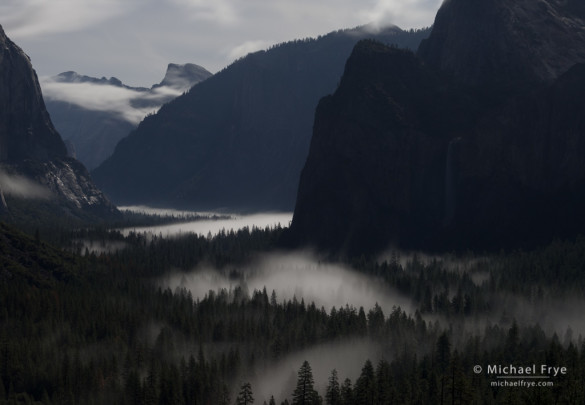








I’ve not been around much and my email-list-receipts are defaulted to No Images because of tracker images put in many emails, so I get no clue what the images are until ready to explore some of the emails. But I noticed the text just now and had to look (it being Sunday helped too). This will be short.
These are ALL absolutely stunning, in both unusual striking light (even for you) and composition. Just a wonderful set. And it’s made my day. Or week. I feel a Facebook Share coming on.
🙂 Thanks, Michael for these.
Thank you very much Andrys – glad you like these!
Michael, you got some wonderful clouds & fog (low clouds?), made all so much sweeter by the possibility of getting totally skunked! Persistence really pays off (as does having a vehicle one can hang out in)!
Thanks Monika. I think fog is right. Funny, I wasn’t worried about getting skunked at all, since I have other moonrise photos from Tunnel View. But the clouds and fog made this better than I expected, so it was a somewhat-surprising treat. I’ll probably be spoiled now – having merely clear skies for a moonrise from Tunnel View will seem rather ordinary. 🙂
Gorgeous gorgeous gorgeous! All of these.
The moonrise with the fog in the tree tops is super fine. The two b+w’s “Chasing Storm” and “Moon, Clouds, and Cathedral Rock” are truly sublime.
Congratulations on the rainfall. My family is in California so I’m praying for a very wet Winter all up and down the State.
Thanks so much Deborah! The two black-and-whites are actually in color, but there’s just not much color to them. And thanks for praying for rain for us – we need all the help we can get!
I noticed the tinge of color in the mountains of the bottom photo… I didn’t realize the b+w’s were from lack of color in the atmosphere.
I love all your work.
Thanks so much for posting these, Michael. We were up there Sunday night as it was our only time available to grab moonrise shots with the moon near Half Dome, but we got shut out with heavy cloud cover and then had to head back. I was going to ask you earlier in the week for the position of the moon, but after checking a few other photos, it seems that the range near Half Dome seems to be 63-73 degrees. Our next opportunity is in January and we’ll be able to make it up during blue hour around Jan 2-4, so we’re hoping for better results then. I think the moon will be in almost the same position, if I’m not mistaken. I would KILL for some of those clouds on the valley floor with that moonrise. Those shots you posted are amazing!
You’re welcome William, and thanks. Are you using an app like PhotoPills or The Photographer’s Ephemeris? That’s the best way to figure out where the moon will be.
Michael – Yes, I’m using TPE, and Photopills and YOUR app, which has been extraordinarily useful over the past couple of years and is HIGHLY recommend to anyone reading these comments. I’ve only had Photopills for a couple of weeks, so I’m still figuring it out, but TPE actually had the moon coming up a bit further North than where it eventually came up. I think it has something to do with the fact that the projected moonrise is at the horizon and it’s another 45 minutes or so until the moon actually makes it above that ridge. I made myself a bit of a rough guide from looking at time stamps on other photos whereby 62-68 degrees puts the moon coming over the ridge to the North of Half Dome, and 69 and above put the moon right above Half Dome or just to the South when shooting from the tunnel. I think anything in the 50’s or 80’s will put the moon a bit out of range of Half Dome, especially when shooting with a 400mm, etc. Looking forward to trying this again in January!
Actually both TPE and PhotoPills can tell you exactly when and where the moon will crest a ridge, not just where and when it will rise above the horizon. They both use a secondary pin that you can place on a ridge. Once you do so you can see the angle of the ridge compared to your viewpoint (where the primary pin is located), and compare that to the angle of the moon. And by moving the time slider you can make the moon “move” and rise, and see when the angle of the moon would be higher than the angle of the ridge. It takes a little experimentation to figure out exactly where the moon might crest the ridge, as the moon moves left/right (or north/south) as well as up, and ridges are uneven, so higher in some spots than others. But it works, and as long as you place the secondary pin in the right spot, it’s extremely accurate. You can figure out exactly where the moon will crest a ridge within a degree or two, and calculate the time within a couple of minutes.
Thanks Michael – Very useful info as I didn’t know about the 2nd pin. I’ll try it out on my next try!
Thank you, Michael for sharing your photos of Yosemite. They are absolutely wonderful. I used to live in Yosemite Valley in the ’80s and I will always have a place in my heart for this beautiful place. I’ve seen many magical moments like this, but to have it captured on camera is priceless. You brought tears to my eyes. Thank you. Keep doing it.
You’re welcome Hollie, and thanks very much for the kind words – I really appreciate that.
Michael, I had my share of beautiful views of Yosemite. And even being far away for quite a long time I keep my memories very much alive through the work of the fantastic wizard Ansel Adams. Your photograph match the beauty and sensibility of the great master. Congratulations. From Brasil, sincerely Rudy Z.
Thanks very much Rudy – I really appreciate that. I bet there are a lot of beautiful landscapes in Brasil. I’ve long wanted to visit Iguazu Falls.
Michael,
I have been enjoying your website since before my trip to Yosemite last August. Your images are stunning and always a highlight of my email inbox.
I currently own a Canon 6D with 2 lenses – 50mm 1.4 and 24-105mm and am looking to add to my . I mainly shoot landscapes(recent trip to CA including Yosemte) and urban photos (Paris, Rome, NY) and wanted to now if you might have a suggestion as to what might be a good next step. I feel I am lacking in something with some reach to it: 70-200, 100-400 and whether you feel going from 4 to 2.8 is valuable.
I have learned a great deal from your website and enjoy the video tutorials immensely and found your article on the 3rd dimension extremely helpful.
All Best
Mike B
Thanks very much for the kind words Michael. I think a 70-200 or 100-400 would be a good choice. The old 100-400 isn’t the sharpest lens around. The new one is supposed to be better, but I haven’t tested it. It’s also heavier and more expensive than a 70-200, but that extra length can be useful. Tough call, and not something I can decide for you. 🙂 As for f/4 vs. f/2.8 (I’m assuming you’re comparing the two versions of the 70-200), is the extra weight (not to mention dollars) worth it for one more stop? In my opinion, no, but I don’t photograph sports, and wildlife only occasionally.
Spectacular images, every one of them! Sending wishes for more storms your way.
Thanks very much Karen!